TOYOTA LAND CRUISER 2017 J200 Owners Manual
Manufacturer: TOYOTA, Model Year: 2017, Model line: LAND CRUISER, Model: TOYOTA LAND CRUISER 2017 J200Pages: 608, PDF Size: 15.88 MB
Page 331 of 608
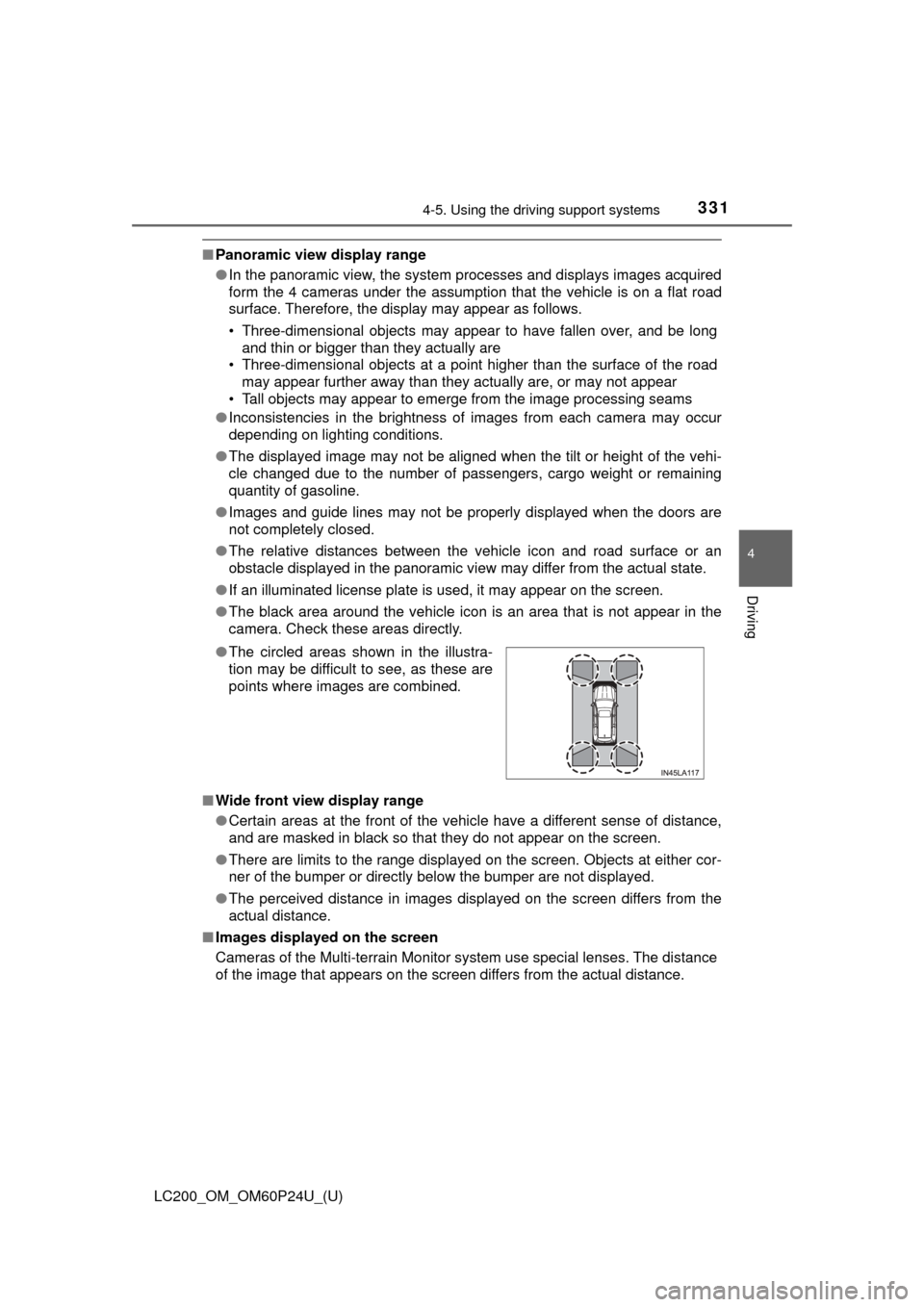
LC200_OM_OM60P24U_(U)
3314-5. Using the driving support systems
4
Driving
■Panoramic view display range
●In the panoramic view, the system processes and displays images acquired
form the 4 cameras under the assumption that the vehicle is on a flat road
surface. Therefore, the display may appear as follows.
• Three-dimensional objects may appear to have fallen over, and be long
and thin or bigger than they actually are
• Three-dimensional objects at a point higher than the surface of the road
may appear further away than they actually are, or may not appear
• Tall objects may appear to emerge from the image processing seams
● Inconsistencies in the brightness of images from each camera may occur
depending on lighting conditions.
● The displayed image may not be aligned when the tilt or height of the vehi-
cle changed due to the number of passengers, cargo weight or remaining
quantity of gasoline.
● Images and guide lines may not be properly displayed when the doors are
not completely closed.
● The relative distances between the vehicle icon and road surface or an
obstacle displayed in the panoramic view may differ from the actual state.
● If an illuminated license plate is used, it may appear on the screen.
● The black area around the vehicle icon is an area that is not appear in the
camera. Check these areas directly.
■ Wide front view display range
●Certain areas at the front of the vehicle have a different sense of distance,
and are masked in black so that they do not appear on the screen.
● There are limits to the range displayed on the screen. Objects at either cor-
ner of the bumper or directly below the bumper are not displayed.
● The perceived distance in images displayed on the screen differs from the
actual distance.
■ Images displayed on the screen
Cameras of the Multi-terrain Monitor system use special lenses. The distance
of the image that appears on the screen differs from the actual distance. ●The circled areas shown in the illustra-
tion may be difficult to see, as these are
points where images are combined.
Page 332 of 608
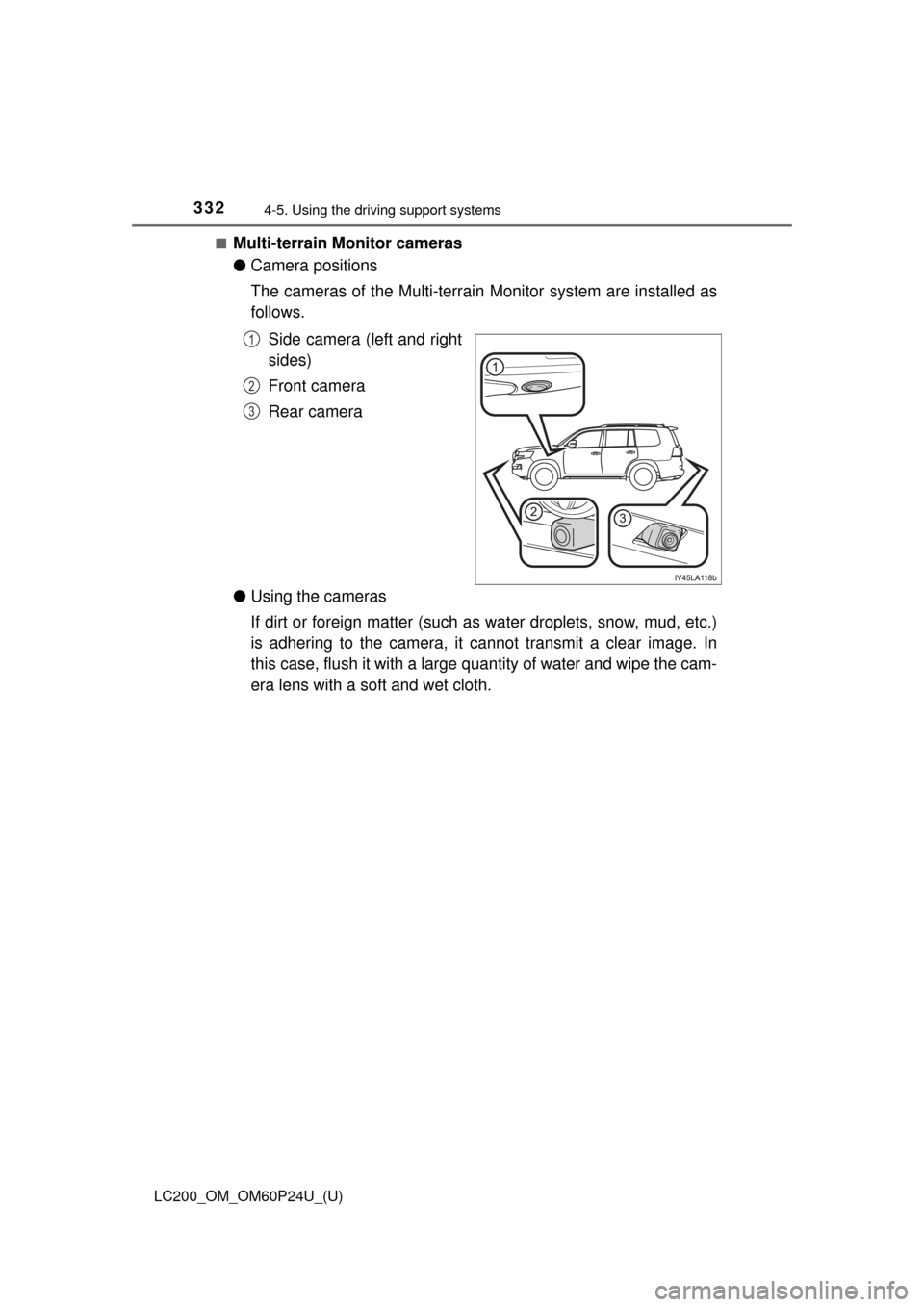
332
LC200_OM_OM60P24U_(U)
4-5. Using the driving support systems
■Multi-terrain Monitor cameras
●Camera positions
The cameras of the Multi-terrain Monitor system are installed as
follows.
Side camera (left and right
sides)
Front camera
Rear camera
● Using the cameras
If dirt or foreign matter (such as water droplets, snow, mud, etc.)
is adhering to the camera, it cannot transmit a clear image. In
this case, flush it with a large quantity of water and wipe the cam-
era lens with a soft and wet cloth.
1
2
3
Page 333 of 608
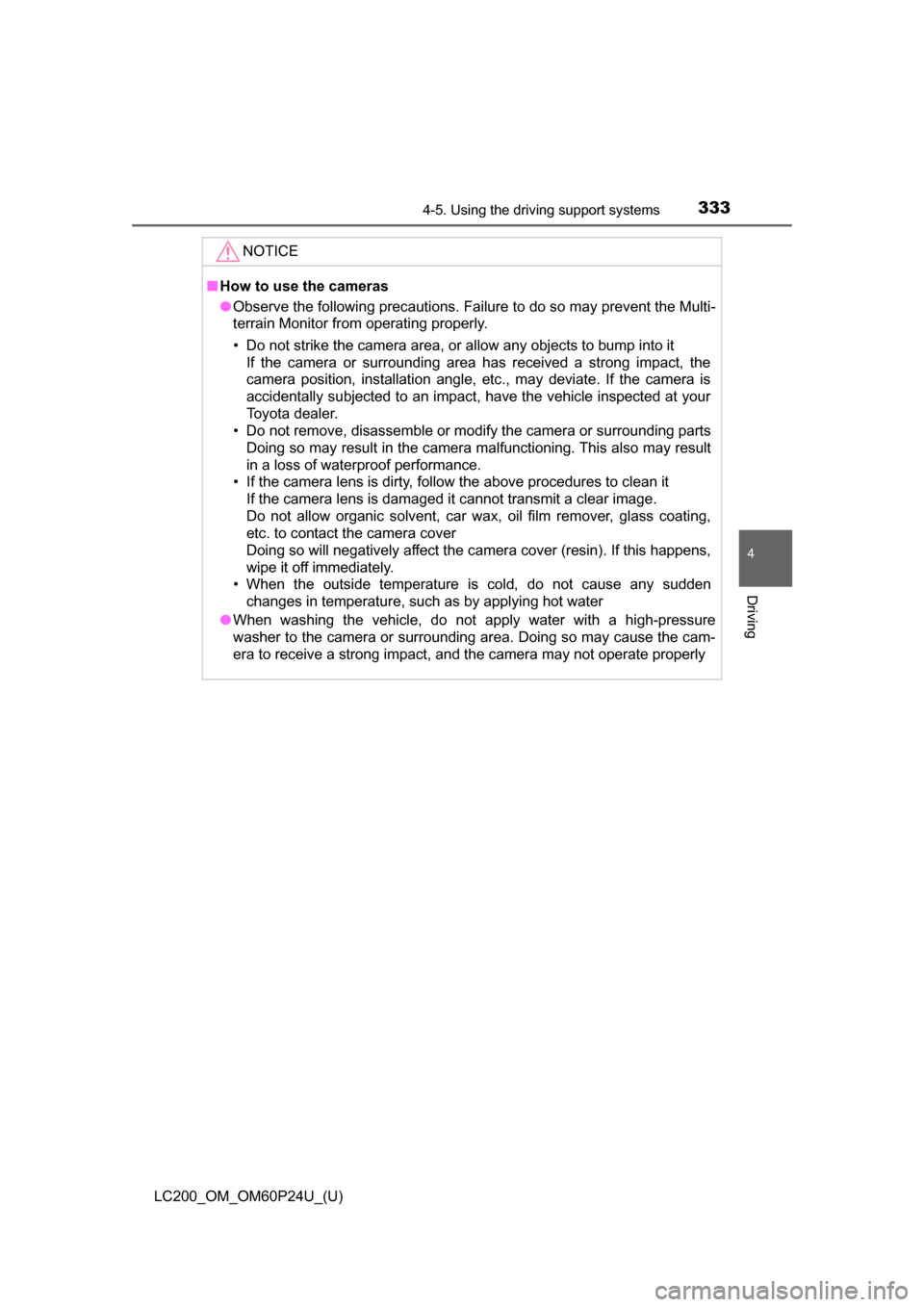
LC200_OM_OM60P24U_(U)
3334-5. Using the driving support systems
4
Driving
NOTICE
■How to use the cameras
● Observe the following precautions. Failure to do so may prevent the Multi-
terrain Monitor from operating properly.
• Do not strike the camera area, or allow any objects to bump into it
If the camera or surrounding area has received a strong impact, the
camera position, installation angle, etc., may deviate. If the camera is
accidentally subjected to an impact, have the vehicle inspected at your
Toyota dealer.
• Do not remove, disassemble or modify the camera or surrounding parts Doing so may result in the camera malfunctioning. This also may result
in a loss of waterproof performance.
• If the camera lens is dirty, follow the above procedures to clean it If the camera lens is damaged it cannot transmit a clear image.
Do not allow organic solvent, car wax, oil film remover, glass coating,
etc. to contact the camera cover
Doing so will negatively affect the camera cover (resin). If this happens,
wipe it off immediately.
• When the outside temperature is cold, do not cause any sudden changes in temperature, such as by applying hot water
● When washing the vehicle, do not apply water with a high-pressure
washer to the camera or surrounding area. Doing so may cause the cam-
era to receive a strong impact, and the camera may not operate properly
Page 334 of 608
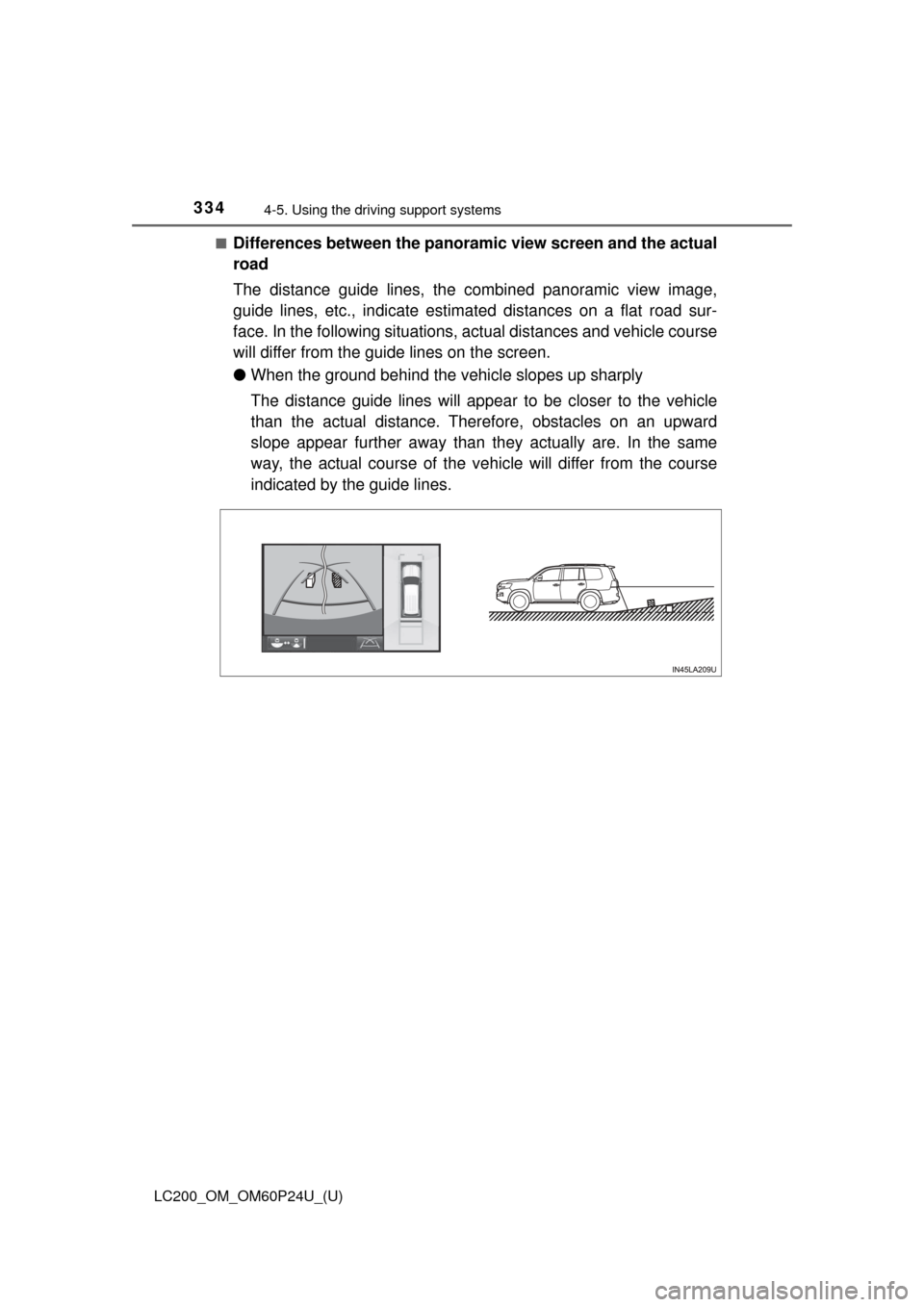
334
LC200_OM_OM60P24U_(U)
4-5. Using the driving support systems
■Differences between the panoramic view screen and the actual
road
The distance guide lines, the combined panoramic view image,
guide lines, etc., indicate estimated distances on a flat road sur-
face. In the following situations, actual distances and vehicle course
will differ from the guide lines on the screen.
●When the ground behind the vehicle slopes up sharply
The distance guide lines will appear to be closer to the vehicle
than the actual distance. T herefore, obstacles on an upward
slope appear further away than they actually are. In the same
way, the actual course of the ve hicle will differ from the course
indicated by the guide lines.
Page 335 of 608
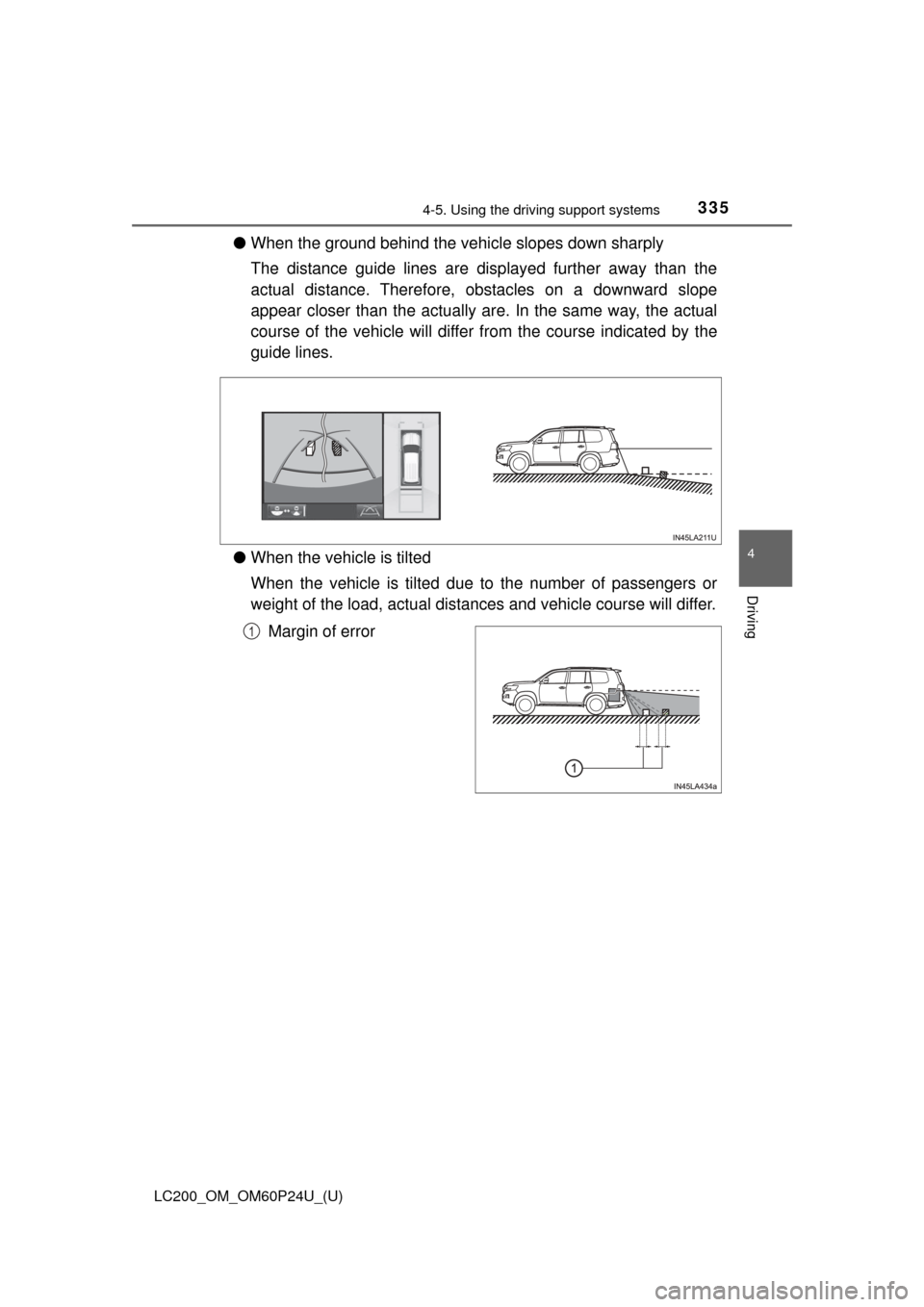
LC200_OM_OM60P24U_(U)
3354-5. Using the driving support systems
4
Driving
●When the ground behind the vehi cle slopes down sharply
The distance guide lines are displayed further away than the
actual distance. Ther efore, obstacles on a downward slope
appear closer than the actually ar e. In the same way, the actual
course of the vehicle will differ from the course indicated by the
guide lines.
● When the vehicle is tilted
When the vehicle is tilted due to the number of passengers or
weight of the load, actu al distances and vehicle course will differ.
Margin of error
1
Page 336 of 608
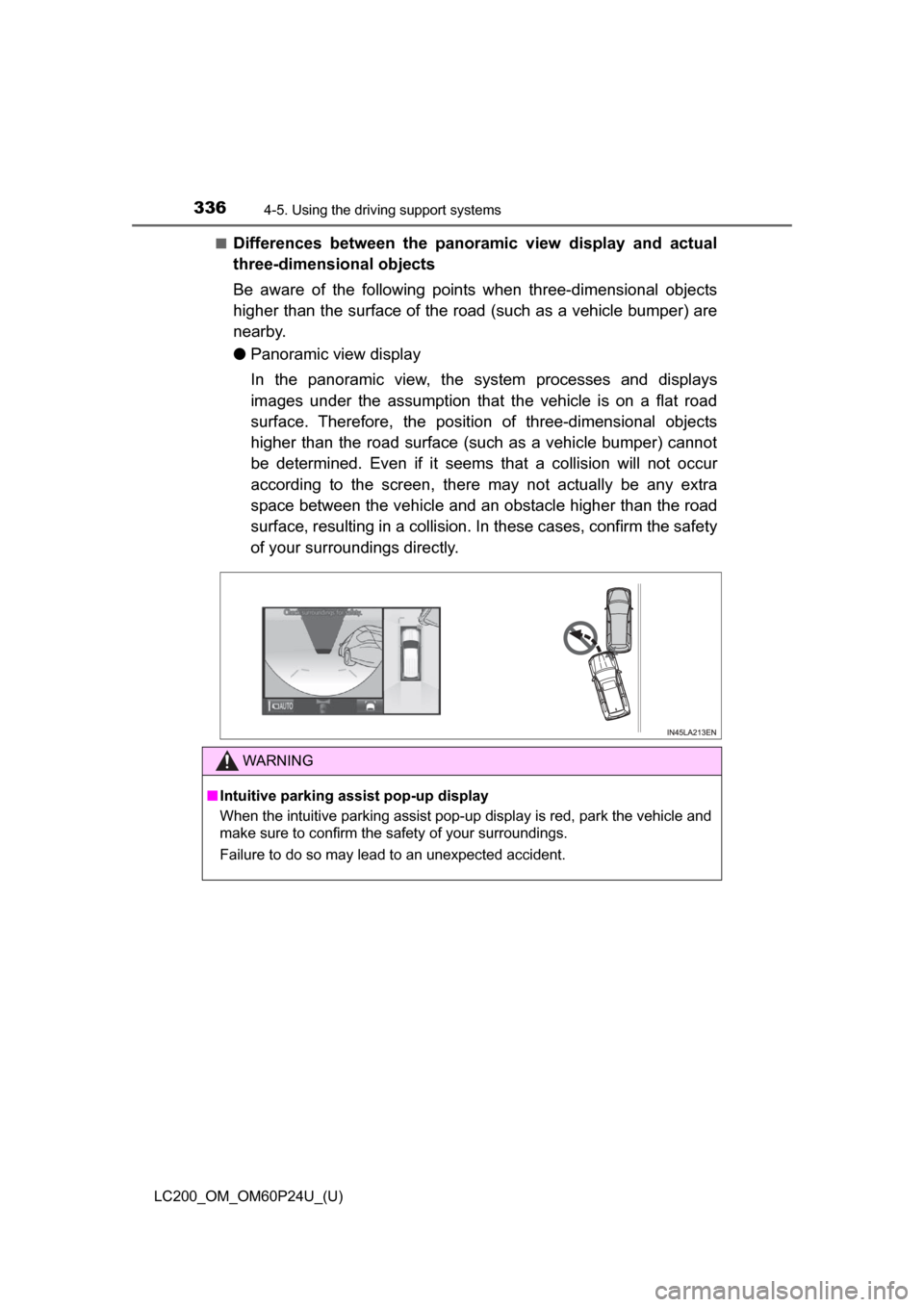
336
LC200_OM_OM60P24U_(U)
4-5. Using the driving support systems
■Differences between the panoramic view display and actual
three-dimensional objects
Be aware of the following points when three-dimensional objects
higher than the surface of the road (such as a vehicle bumper) are
nearby.
●Panoramic view display
In the panoramic view, the system processes and displays
images under the assumption that the vehicle is on a flat road
surface. Therefore, the position of three-dimensional objects
higher than the road surface (such as a vehicle bumper) cannot
be determined. Even if it seems that a collision will not occur
according to the screen, there may not actually be any extra
space between the vehicle and an obstacle higher than the road
surface, resulting in a collision. In these ca ses, confirm the safety
of your surroundings directly.
WARNING
■ Intuitive parking assist pop-up display
When the intuitive parking assist pop-up display is red, park the vehicle and
make sure to confirm the safety of your surroundings.
Failure to do so may lead to an unexpected accident.
Page 337 of 608
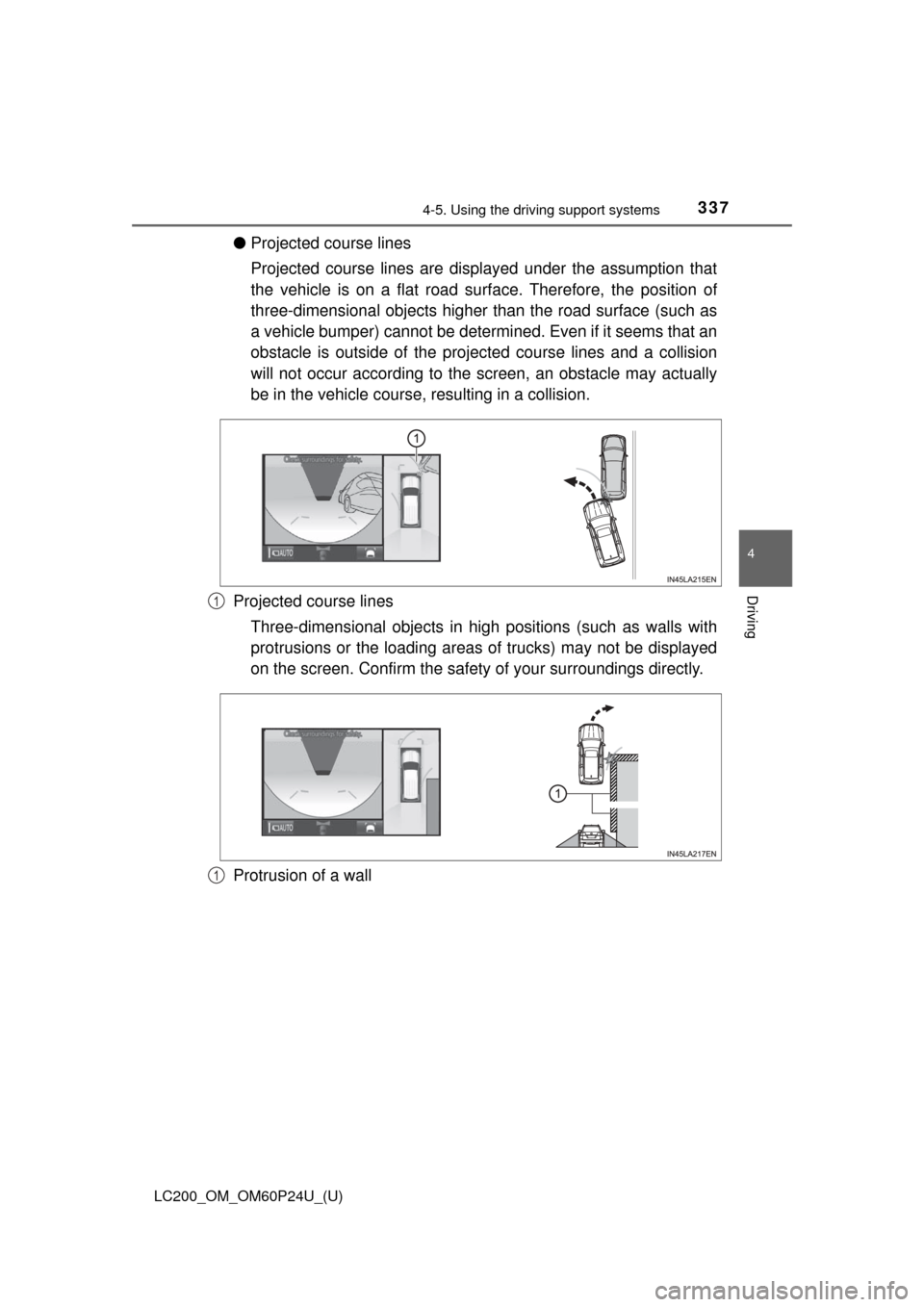
LC200_OM_OM60P24U_(U)
3374-5. Using the driving support systems
4
Driving
●Projected course lines
Projected course lines are displayed under the assumption that
the vehicle is on a flat road su rface. Therefore, the position of
three-dimensional objects higher than the road surface (such as
a vehicle bumper) cannot be deter mined. Even if it seems that an
obstacle is outside of the projec ted course lines and a collision
will not occur according to the screen, an obstacle may actually
be in the vehicle course, resulting in a collision.
Projected course lines Three-dimensional objects in high positions (such as walls with
protrusions or the loading areas of trucks) may not be displayed
on the screen. Confirm the safety of your surroundings directly.
Protrusion of a wall
1
1
Page 338 of 608
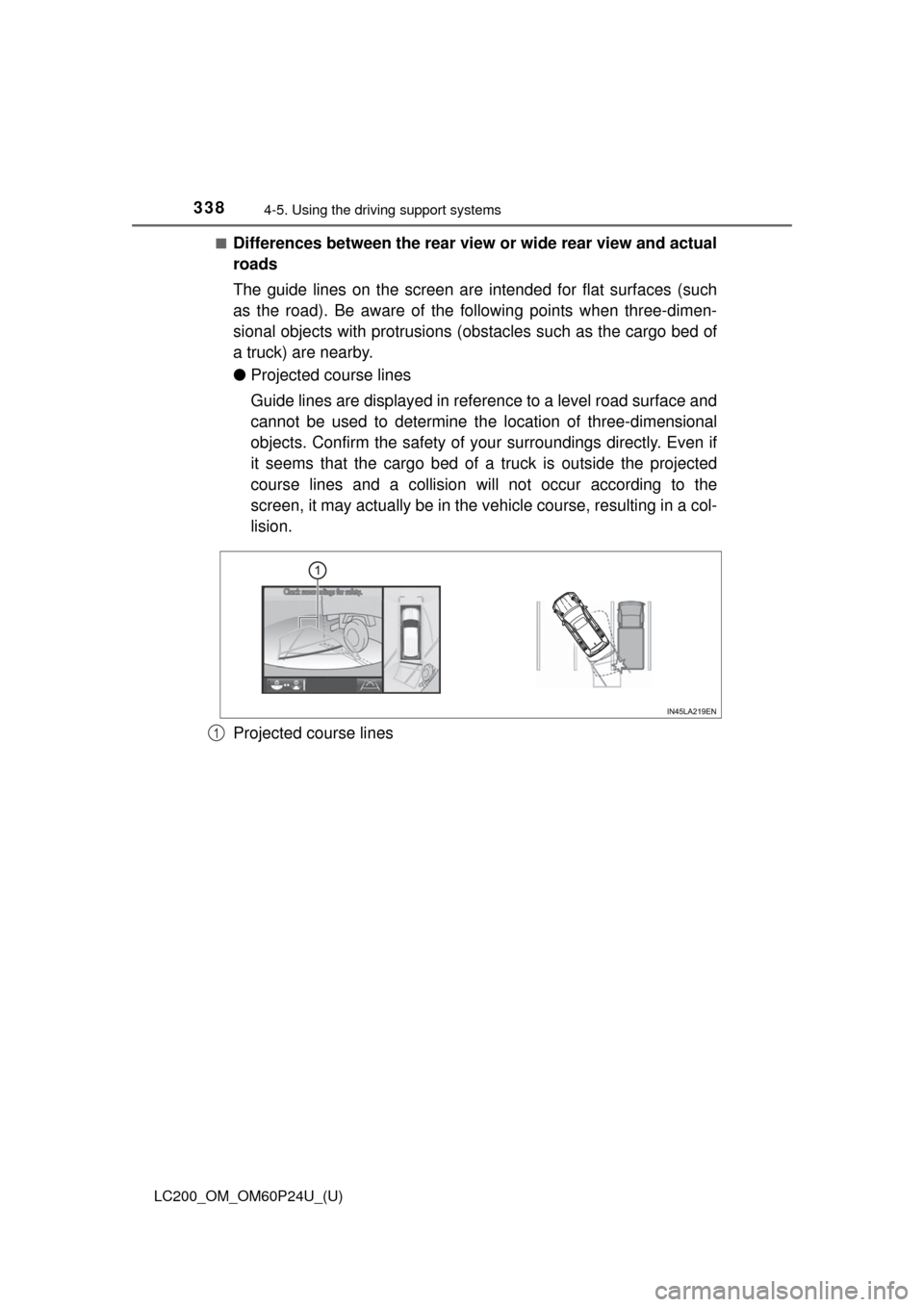
338
LC200_OM_OM60P24U_(U)
4-5. Using the driving support systems
■Differences between the rear view or wide rear view and actual
roads
The guide lines on the screen are intended for flat surfaces (such
as the road). Be aware of the following points when three-dimen-
sional objects with protrusions ( obstacles such as the cargo bed of
a truck) are nearby.
● Projected course lines
Guide lines are displayed in reference to a level road surface and
cannot be used to determine th e location of three-dimensional
objects. Confirm the safety of your surroundings directly. Even if
it seems that the cargo bed of a truck is outside the projected
course lines and a collision will not occur according to the
screen, it may actually be in the vehicle course, resulting in a col-
lision.
Projected course lines
1
Page 339 of 608
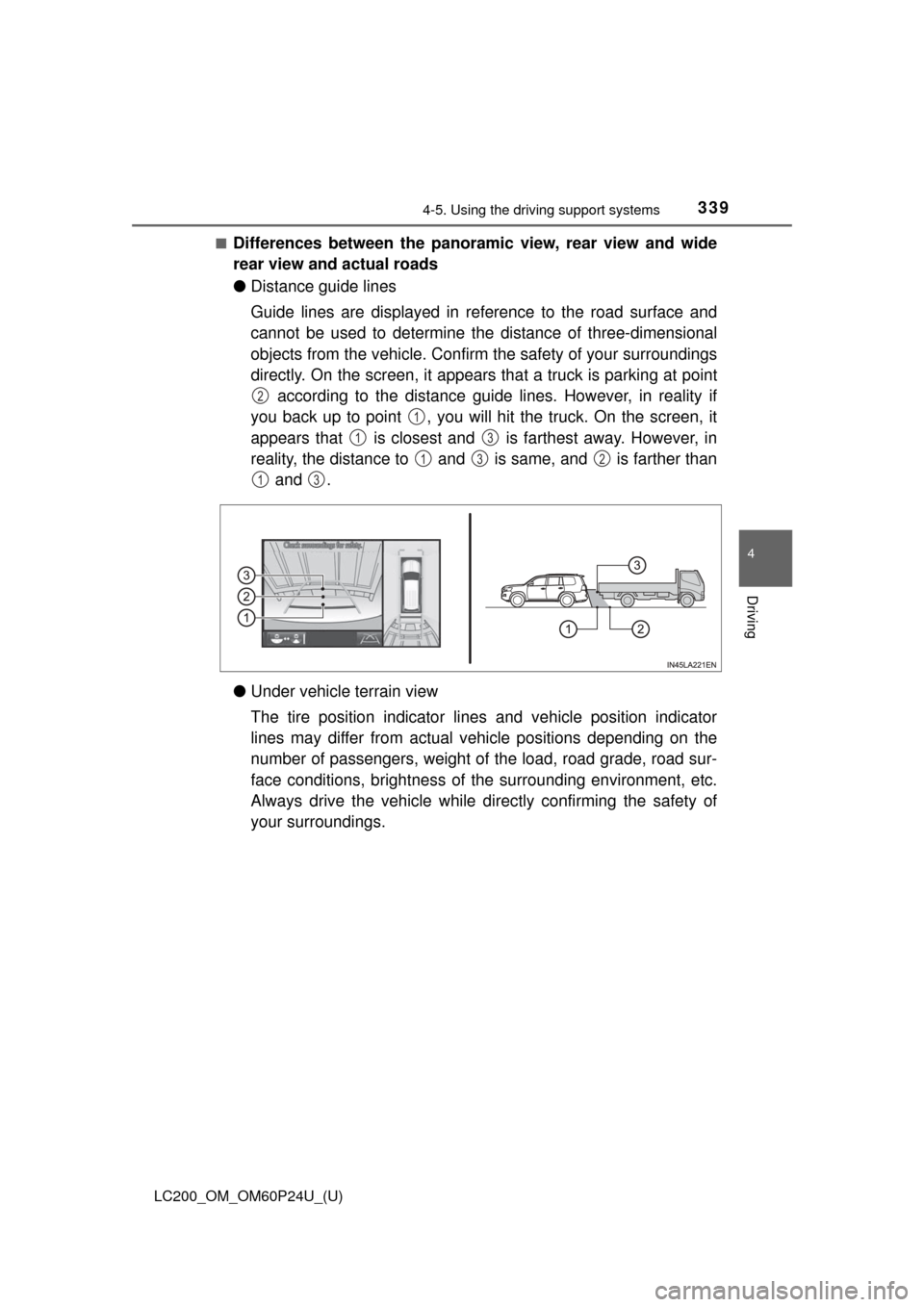
LC200_OM_OM60P24U_(U)
3394-5. Using the driving support systems
4
Driving
■Differences between the panoramic view, rear view and wide
rear view and actual roads
●Distance guide lines
Guide lines are displayed in reference to the road surface and
cannot be used to determine th e distance of three-dimensional
objects from the vehicle. Confirm the safety of your surroundings
directly. On the screen, it appears that a truck is parking at point according to the distance guide lines. However, in reality if
you back up to point , you will hit the truck. On the screen, it
appears that is closest and is farthest away. However, in
reality, the distance to and is same, and is farther than and .
● Under vehicle terrain view
The tire position indicator lines and vehicle position indicator
lines may differ from actual v ehicle positions depending on the
number of passengers, weight of the load, road grade, road sur-
face conditions, brightness of the surrounding environment, etc.
Always drive the vehicle while directly confirming the safety of
your surroundings.
2
1
13
132
13
Page 340 of 608

340
LC200_OM_OM60P24U_(U)
4-5. Using the driving support systems
■Using under vehicle terrain view
●The images displayed were previously taken approximately 10 ft. (3 m)
behind the current vehicle position.
Therefore, actual conditions may differ from those shown on the screen in
the following situations.
• An obstacle has appeared after the image was taken
• Loose material like sand or snow has crumbled or shifted
• An obstacle has moved
• There is a puddle, tract of mud, etc., within the display range
• The vehicle slips
● In the following situations, actual tire positions and vehicle position may dif-
fer from those indicated by the tire position indicator lines and vehicle posi-
tion indicator lines.
• Tires have been replaced
• Optional equipment has been installed
WARNING
■ Guide lines
The displayed guide lines are composed with the image that was previously
taken and may differ from the actual state. Always drive the vehicle while
confirming the safety of your surroundings.